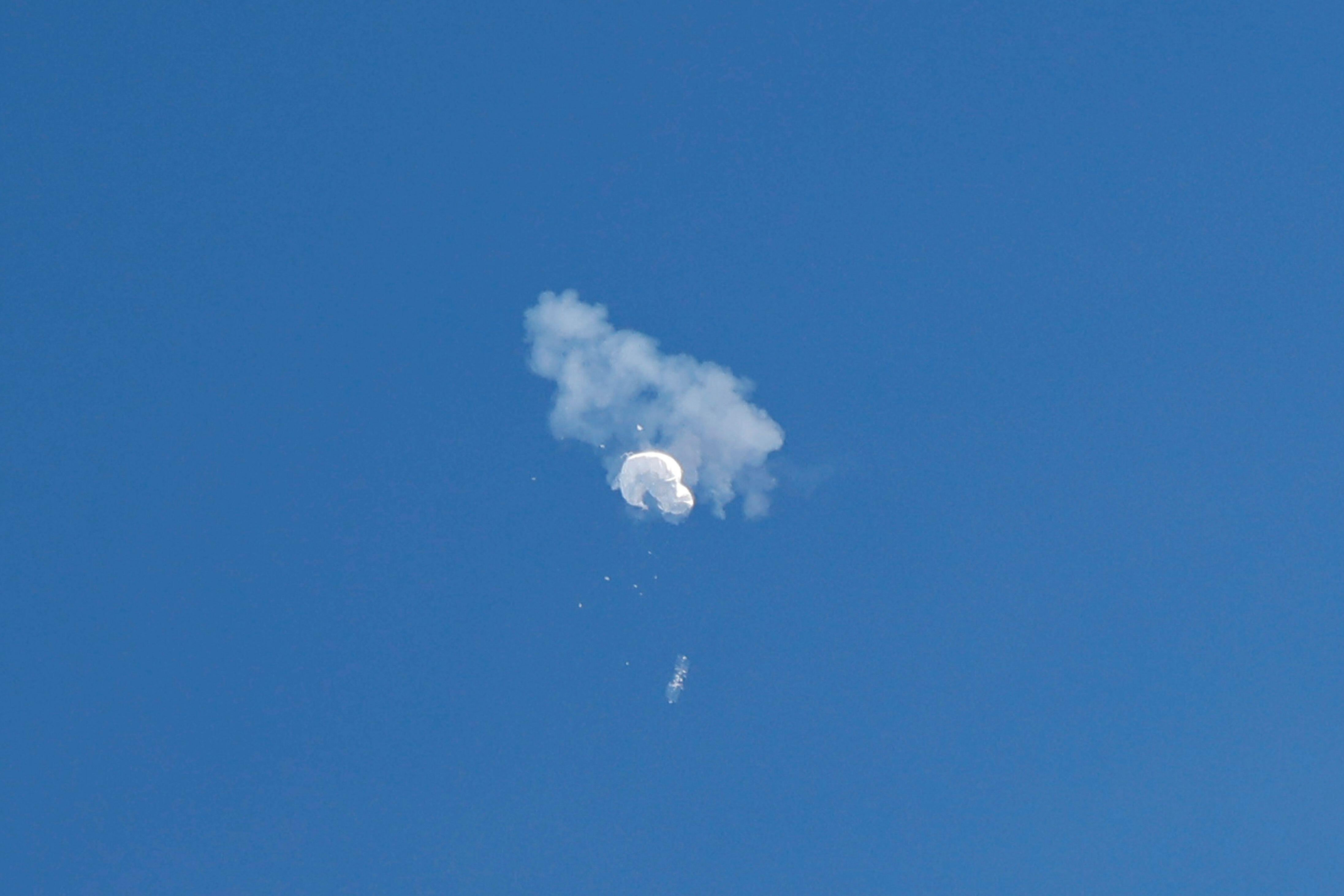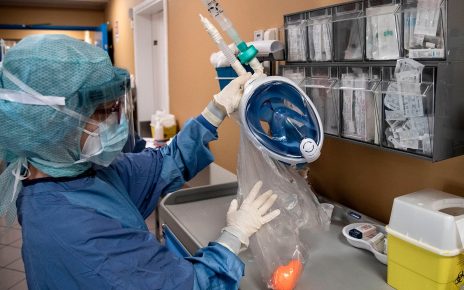
On February 4 the U.S. shot down a massive Chinese surveillance balloon over the Atlantic Ocean just off South Carolina, after it spent days traveling across the country. As Americans turned their eyes to the sky, it became apparent that the object was not alone: news soon broke that another Chinese spy balloon was floating over Latin America, and that several such balloons had encroached on U.S. airspace since 2018—and had evaded early detection at the time. China has claimed that the balloon shot down last week was merely a weather-monitoring station blown off course. But the U.S. has since recovered sensors and other electronic equipment from the wreckage, which indicate that it was likely used for eavesdropping on electronic signals. Chinese officials also claimed that the U.S. has sent surveillance balloons over their country, but U.S. officials deny this.
With attention heightened, over the past few days the U.S. shot down three more airborne objects: one off the coast of Alaska on Friday, one over Canada on Saturday, and one over Lake Huron in Michigan on Sunday. Much remains unknown about the three most recent objects, including where they came from, if they carried surveillance equipment and whether they were even balloons or some other airborne craft.
Here is everything we know—and don’t know—about all the balloon brouhaha.
Just how many balloons are usually floating over the U.S., and who is keeping track of them?
At any given time, there could be hundreds or thousands of floating objects overhead—but the vast majority are innocuous. For instance, nearly 100 National Weather Service (NWS) sites release balloons twice a day to measure things like temperature and humidity. These latex balloons, filled with either hydrogen or helium, do not remain airborne for long; they burst as a result of changes in pressure as they ascend. The attached instruments drift safely back down on parachutes. Such balloons monitor weather and also offer researchers an affordable way to carry instruments into the upper atmosphere, often with GPS trackers so the scientists can retrieve them when they land. Amateurs sometimes attach cameras to similar balloons in order to snap impressive vistas. Government organizations also use tethered helium balloons, called aerostats, as platforms for their radar systems. And at lower altitude—thousands of feet in the air rather than tens of thousands—you’ll find hobbyists and tourists borne aloft in hot-air balloons.
“There’s probably at least 100 [large balloons] in the air, on any given day,” says Mick West, a writer and investigator of unidentified aerial phenomena, or UAPs.
Radar can detect all of these objects, in addition to the occasional bird, some clouds and the many mylar party balloons that go whizzing into the sky each year. But monitoring every little airborne speck would create too much instrument noise, making it difficult to pick out actual threats. Because of this, the North American Aerospace Defense Command (NORAD), a combined U.S.-Canada defense organization, uses algorithms to filter smaller objects out of radar readings. But the U.S. Federal Aviation Administration tries to keep track of large balloons that can reach the altitudes where commercial aircraft fly, at roughly 30,000 to 40,000 feet. This requires that entities such as NWS and universities register their balloons launches (although amateur enthusiasts do not always follow the same protocols).
Since last week, government representatives have announced that, among the many balloons in our skies, some may have been Chinese spying platforms. “At least since 2018, there does seem to seem to be this broad Chinese balloon surveillance program,” says Carla Martinez Machain, a professor of political science at the University at Buffalo. According to the State Department, China’s balloon surveillance program goes well beyond the U.S., targeting 40 countries on five continents.
If China has been sending balloons our way for so long, why are we only detecting them now?
It’s pretty simple: “Now that the U.S. military and the U.S. government are looking for them, we’re probably more likely to see them,” Machain points out.
The surveillance balloon that brought this program to national attention was easily detectable—so large that civilians managed to take photos and videos of it from the ground. It was widely estimated to be the size of three school buses. “It’s not very stealthy,” West says. “The payload underneath it was about the size of a small plane, so it … looks like a plane on the radar.”
Once the U.S. government identified that object, it reexamined other cases of balloons that had been detected in U.S. airspace and realized that some of those—at least three during the Trump administration and one earlier in the Biden administration—had also been Chinese surveillance platforms. “They sent a few of these, not into the very heart of the U.S., but around it. And [they] hadn’t been detected,” says Tai Ming Cheung, director of the Institute on Global Conflict and Cooperation at the University of California, San Diego. As a result of these discoveries, NORAD began monitoring smaller objects that had previously flown under the radar—literally.
Remember how NORAD’s radar detection system filters out smaller objects? Since the detection of the large surveillance balloon, the organization has been widening that filter to pick up signals such as those from the three balloons shot down this weekend. “Previously, they had things set up to filter out what they would describe as clutter on the radar,” West explains. “These newer ones are the result of a heightened sense of caution.… [They] modified the algorithm that they use to determine whether something is of interest or not, and so things that have been there all along are now popping up for the first time.”
So what do we know about the objects that were shot down the past weekend?
Not a lot! At a White House press briefing on Monday, National Security Council Coordinator for Strategic Communications John Kirby said the objects did not appear to maneuver or move under their own propulsion, which suggests they may have been balloons. This remains the most likely explanation, although some reports suggest the object shot down on Friday broke apart on impact, which could mean it was another type of flying vehicle.
“The information I’ve seen is that they’ve been described as being the size of a small car, roughly speaking,” says Iain Boyd, director of the Center for National Security Initiatives at the University of Colorado Boulder. “That’s pretty big for a drone or something like that. I guess it could be a dirigible … [or] some kind of experimental vehicle, whether it’s from … China or somewhere else.” Observations of the other two objects remain equally light on detail. The one shot down Saturday over Canada apparently had a cylindrical shape; the one shot down Sunday over Michigan seemed octagonal and had “strings” hanging off it.
According to Kirby, these three objects also did not appear to be sending out communications or to carry any crew, which adds to the theory that they were innocuous—perhaps even research balloons that merely drifted off course. But if they were so harmless, why did the U.S. shoot them down? One answer, provided by NORAD’s official statements, is that these objects were flying at 20,000 to 40,000 feet, potentially posing a risk to civilian airplanes.
In contrast, the Chinese surveillance balloon that first drew national attention remained at a higher altitude of about 60,000 feet, out of the way of other aircraft. It was also so large that shooting it down over inhabited areas had more potential to cause damage when it landed. And because the balloon remained in the air for longer, we know more about it. As it drifted, U-2 spy planes observed the object in action and monitored what it was doing. And once it landed in the Atlantic Ocean, the U.S. retrieved the remains, and has already begun studying it.
What data was the larger balloon collecting? What was it capable of?
Balloons can use photos and videos to observe the ground. But if a nation has access to satellites (as China does), the space-based tech is already providing detailed visual surveillance without the risk of being shot down by U.S. planes. Based on the remains recovered thus far, the larger balloon shot down last week seems to have been collecting electronic communications, such as mobile phone and radio transmissions. “These objects were, in some cases, flying over military sensitive areas, bases and missile sites and things like this,” Boyd says. “Part of what [its] electronic surveillance could be trying to do is understand what are the communications that are being sent out from these military sensitive areas, and trying to learn about the nature of the signals that are used … perhaps with a view to being able to disable them.” Knowing the frequency and amplitude of military communications near missile silos could enable an adversary to “jam” those signals to prevent communications. Of course, this ability works the other way as well; while the balloon was still aloft, a senior defense official said that “We are taking steps … to protect against foreign intelligence collection of sensitive information.” This hinted that the U.S. was jamming the balloon’s electronics so it could not gather or transmit data.
In addition to listening in on communications, the balloon could have enabled China to monitor the U.S. response to the intrusive object. “It could be a test to see, ‘How able is the U.S. to detect this type of technology, when do they become aware of it, how easy is it for the U.S. to shoot it down?’” Machain says. Knowing about the U.S. capacity for countering a balloon could be useful in a potential future in which such a craft is designed to carry weapons, she adds. “If you were to have a balloon, and if you were to arm it, you want to know, ‘Can the other side detect it, and when do they detect it?’” Although some balloons have historically carried weapons—Japan notably deployed incendiary balloons against the U.S. during World War II—none of the new objects discovered thus far seem to have been armed.
They could still serve a military purpose, however. “There’s a lot of focus on ‘the Chinese were going over these intercontinental ballistic missile sites’” with the earlier balloon, Cheung says. “And that fits into a deepening of the nuclear arms race. The Chinese are building up their nuclear weapons capability, especially their intercontinental capabilities.” Spying on missile sites in the heart of the U.S. could provide their military with valuable information about the country’s nuclear capabilities.
Could weapons-carrying balloons move over those specific military sites?
Another reason balloons are not the best platforms for weapons delivery is that, although they excel at evading radar, they are difficult to steer. Still, operators can exert some control over a balloon’s position by making it rise or fall. “Because the wind speed varies at different altitudes, they can use that to basically change direction and steer to a certain amount,” West says. This enables some balloons to essentially hover over a ground position. “And you could, in theory, put some rudders and propellers on a balloon.” These would be of limited utility, West adds, because a balloon’s size puts it at the mercy of the wind—and takes a lot of propeller power to overcome that. But Boyd notes that propellers could allow a balloon to make small shifts in position that could have a big effect. “With propellers, then I think you could overcome some of the wind and you could move from side to side.… You can imagine designing a trajectory; you’re mostly going from west to east, but you’re able to go north-south to some extent if you have some kind of propulsion system.”
The smaller shot-down objects, which thus far have displayed fewer capabilities than the large balloon, did not show any signs of independent steering. “They haven’t confirmed that they were balloons, but I think it’s likely that most of them were,” Boyd says, although he is reluctant to speculate. “We’re talking about UFOs at some point.”
Wait, all I heard was “UFOs.” Could these unidentified flying objects be alien spacecraft?
At a recent press briefing, White House spokesperson Karine Jean-Pierre said, “There is no—again—no indication of aliens or other extraterrestrial activity with these recent takedowns.” The objects displayed no unknown technology and failed to resist the missiles that blew them out of the air. Instead of alien craft being mistaken for balloons, the opposite situation is more common.
In recent years, both NASA and the Department of Defense have shown renewed interest in unidentified aerial phenomena (UAP). Some of this increased scrutiny has indeed been enlightening: “The recent UAP reports that came out in January … they listed a whole bunch of new UAPs, and the vast majority of the ones that they identified were balloons, simply because it’s such a common thing to be in the air,” West says. Among the UAPs that were actually full of hot air, it’s possible that some were performing surveillance on behalf of other countries. This explanation is much more likely than extraterrestrial activity.
“It would be quite a story if these balloons—objects two, three and four—were from aliens, and they just happened to come along a week after this giant Chinese … balloon was shot down,” Boyd says. “That just adds to all the incredulity that would go along with that.”
Well, that’s disappointing. Are you absolutely, positively sure it’s not aliens?
I guess anything is possible! After all, the U.S. military has refused to definitively shoot down the alien theory. “In a military context, you never want to rule anything out—which is why they haven’t ruled out aliens,” West says. “Out of an abundance of caution, you really want to consider all the possibilities.”



